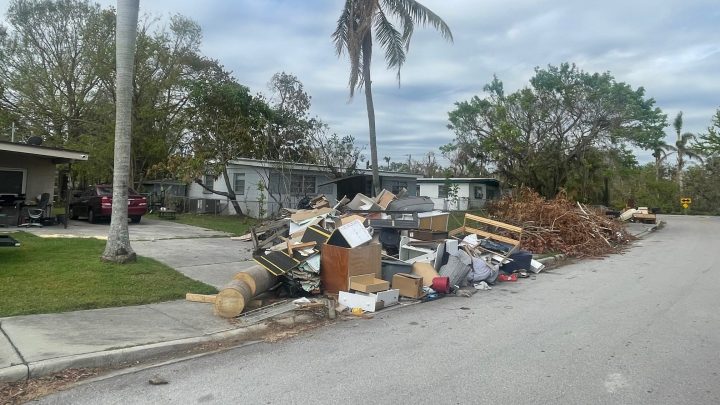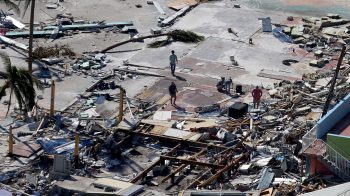
Southwest Florida had an affordable housing shortage. Hurricane Ian made it worse.
Southwest Florida had an affordable housing shortage. Hurricane Ian made it worse.

The city of Fort Myers and surrounding Lee County took serious damage when Hurricane Ian slammed into Southwest Florida nearly two months ago. Category 4 winds, the storm surge and heavy rain combined to inflict damage and flooding along the coast and inland.
Tens of thousands of displaced residents are still living in shelters, FEMA-sponsored motels, temporary rentals, campers and RVs, or crashing with friends and family. And in an area that was already suffering from an affordable housing crisis, the storm has just made matters worse.
About a month ago, with clean-up from Hurricane Ian well underway, the devastation wrought by high sustained winds and flooding of multiple rivers, creeks and canals could be seen along most residential streets.
“So, you see how close we are to the river, that’s the Caloosahatchee River,” said Abdul’Haq Muhammed during a driving tour of the area. Muhammed is founder and executive director of the Quality Life Center of Southwest Florida, a local community organization that serves the predominantly African American and Latino working-class neighborhoods east of downtown.
On one side of a street in East Fort Myers, near the riverfront, one could see modest single-family wood-frame and mobile homes. On the other side were more modern upscale homes and condos, some with waterfront views.
“So homes are being bought by corporations — out-of-town corporations, often,” said Muhammed, “and they’re renovated and then put back out on the market at a level that is unaffordable for people in that community.”
There was obvious storm damage to both kinds of homes. But Muhammed said it was renters and owners of older houses and mobile homes he was most worried about, as many of them aren’t adequately insured and may not be able to rebuild or remain.
“As you look down these blocks, you’ll see debris, household furniture — in some areas is about as tall as the houses,” he said.
“You may see a home that kind of looks OK from the outside,” said Gladys Cook, director of resilience and recovery at the Florida Housing Coalition. “But there’s a pile of debris in the front yard that has all of their drywall, carpeting, all their cabinets, beds. So you know that that house had leaking or was flooded, and those people can’t live in the home. And there’s thousands of people in that situation.”
Hurricane Ian made landfall along the coast in Lee County just west of Fort Myers, and the county took the worst damage in the state. More than 5,000 homes were assessed by their owners as destroyed after the hurricane; nearly 30,000 more sustained severe damage. More than 14,000 households in the county are currently eligible for Transitional Sheltering Assistance, according to FEMA.
Meaning, displaced storm victims face a big challenge: trying to find a new place to live while they’re living short-term in a shelter or FEMA-sponsored motel; a temporary rental; a camper or RV; or staying with friends or family.
“We were already a million units short of affordable housing in Florida before the disaster,” said Cook. “And then when you take out all those mobile homes — you’re really looking at a long-term problem.”
Subsidized housing isn’t a realistic option for most either, Cook said. “The assisted apartment complexes, they’re at 100% occupancy, so there aren’t any apartments to move into.”
Mellone Long had to leave the duplex where she was renting after it flooded in the storm.
Several weeks ago, she attended a FEMA information session to find out about assistance programs. It was held at a local high school and organized by neighborhood churches and community groups, including the Quality Life Center.
“It’s really hard to lose like 90% of everything you ever owned,” Long said. “I mean, it’s just gone. And then you think you can go to work for some peace. But you can’t, because you lost like 90% of your stuff at work.”
Long is grateful that she has a job. She works for the Fort Myers Community Redevelopment Agency. After evacuating during Hurricane Ian, Long and her two dogs moved in with a friend while searching for a new place to rent.
“So I looked everywhere in Fort Myers. There was nothing available,” she said. “And so I looked for a place outside the city, and the waiting lists are long, and there are, like, a thousand people who want to rent there.”
“OK, you have an issue of a hurricane here, but prior to the hurricane, this momentum was already in motion,” said Abdul’Haq Muhammed. He pointed out that property values have soared in desirable coastal areas like Fort Myers, as developers and wealthy homebuyers flock in.
But the area also needs service workers and public servants like teachers and social workers, he said. And they need affordable housing nearby. Instead, he said, “people’s rents are constantly going up. It’s going to push people out — further inland, which now pushes them further away from employment opportunities.”
Mellone Long has found a new rental. But it’s not in Fort Myers, and her commute will be longer. “So I’ll be OK,” she said. “It is more than what I was paying, and you just — you gotta have a roof over your head, right?”
Nearly two months after Hurricane Ian hit, FEMA is getting ready to install the first temporary trailers for displaced homeowners in Florida. And the state has just announced a program to provide travel trailers and RVs to homeowners and renters who still need more stable shelter.
There’s a lot happening in the world. Through it all, Marketplace is here for you.
You rely on Marketplace to break down the world’s events and tell you how it affects you in a fact-based, approachable way. We rely on your financial support to keep making that possible.
Your donation today powers the independent journalism that you rely on. For just $5/month, you can help sustain Marketplace so we can keep reporting on the things that matter to you.

















